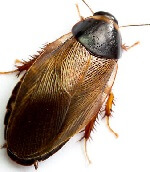Surinam Cockroach Facts

The world of insects never ceases to amaze me. Every day, there’s a new discovery, a new species to learn about, or a new characteristic that leaves us astounded. The Surinam cockroach (Pycnoscelus surinamensis) is no exception.
Native to the lush, tropical environs, this small yet fascinating cockroach has many unique attributes. Let’s dive into understanding more about this creature.
Quick Facts
| Attribute | Description |
|---|---|
| Size | ~1 inch |
| Color | Black/brown with olive-green or dark brown wings |
| Habitat | Underground, warm and moist areas |
| Diet | Plant stems and roots |
| Geographical Presence | Tropical regions, e.g., Southeastern United States |
| Reproduction | Asexual, oviparous |
| Control Tips | Clear moist areas, seal exterior cracks, fit screens |
Appearance
As with many other insects, the Surinam cockroach has specific physical attributes that distinguish it from its brethren.
- Size: These creatures measure around an inch in length, making them small yet visible.
- Color: Their bodies are painted in dark black or brown shades, accompanied by olive-green or deep brown wings draping across their back. This camouflage assists them in blending seamlessly into the soil and foliage.
- Body: Don’t be deceived by their size; Surinam cockroaches are robust creatures. With a glossy, shield-shaped head and stout form, they are armored for their subterranean lifestyle.
Feeding Habits
One would think the diet of an underground dweller might be limited. However, the Surinam cockroach, with its penchant for plant-based nutrition, manages quite well.
Preferring to munch on plant stems and roots, this cockroach plays an essential role in the ecosystem by aiding in the decomposition and recycling of organic matter.

Habitat & Behavior
There’s something eerily fascinating about creatures of the night. The Surinam cockroach, being nocturnal, adds to this allure. Spending most of their lives underground, they are masters of evasion.
Their preference for warmth and moisture makes them vulnerable to cold winters, ensuring they stay in tropical, humid regions.
Distribution
Surinam cockroaches flourish in regions that mirror their natural habitat. Thus, they are commonly sighted in humid, tropical areas. Notably, the southeastern United States stands as a major hub for this species.
Reproduction
When it comes to reproduction, Surinam cockroaches challenge our traditional understanding. Only females play a crucial role in the propagation of their species, as they reproduce asexually. This is a phenomenon where organisms can reproduce without needing male fertilization.
Furthermore, these cockroaches display an oviparous mode of reproduction. Females retain their egg cases internally until the nymphs are ready to hatch. A single female can bear up to three egg cases, with each case encapsulating an average of 24 eggs. Remarkably, there’s no seasonal break; reproduction is a year-round affair.
Tips for Control
While the Surinam cockroach isn’t typically a household nuisance, it’s wise to keep populations in check due to potential health concerns. They can transport disease-causing bacteria, so here’s what you can do:
- Declutter: Eliminate leaf piles and trash. These provide moist havens for these cockroaches.
- Fortify your Home: Ensure that all exterior cracks are sealed. These can act as gateways for cockroaches to invade.
- Reinforce Vents: Ensure foundation and attic vents are fitted with secure screens to prevent unwelcome guests.
Conclusion
In conclusion, the Surinam cockroach is a testament to nature’s marvels. Its unique reproductive methods and subterranean lifestyle make it a creature worth understanding and respecting. As with all creatures, it’s essential to maintain a balance in their population, ensuring a harmonious coexistence.

James E. Butkovich, Pest control maven with a knack for eco-friendly & Chemical solutions. Blogger with a mission to make homes pest-free, one post at a time.